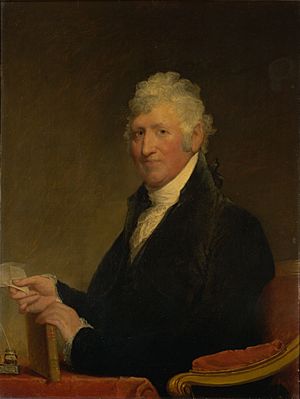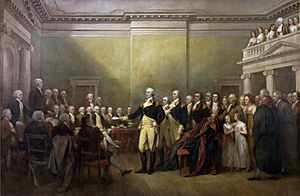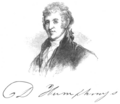David Humphreys (soldier) facts for kids
Quick facts for kids
David Humphreys
|
|
|---|---|

Humphreys depicted in a portrait by Gilbert Stuart, circa 1808 to 1810
|
|
| 3rd United States Minister to Spain | |
| In office September 10, 1797 – December 28, 1801 |
|
| President | John Adams Thomas Jefferson |
| Preceded by | William Short |
| Succeeded by | Charles Pinckney |
| 1st United States Minister to Portugal | |
| In office May 13, 1791 – July 25, 1797 |
|
| President | George Washington John Adams |
| Preceded by | Position established |
| Succeeded by | William Loughton Smith |
| Personal details | |
| Born | July 10, 1752 Derby, Connecticut, British America |
| Died | February 21, 1818 (aged 65) New Haven, Connecticut, U.S. |
| Resting place | Grove Street Cemetery |
| Spouse | Anne Frances Bulkeley |
| Education | Yale University (B.A., M.A.) |
| Occupation | Diplomat, poet, entrepreneur |
| Military service | |
| Allegiance | |
| Branch/service | |
| Years of service | 1776–1783 |
| Rank | Lieutenant Colonel |
| Battles/wars | American Revolutionary War |
David Humphreys (born July 10, 1752 – died February 21, 1818) was an important American figure. He was a colonel in the American Revolutionary War and a close helper to George Washington. He also worked for Benjamin Franklin in Paris. Later, he became an ambassador for the United States in Portugal and Spain. Humphreys was also a businessman who brought special Merino sheep to America. He was a talented poet and writer too.
Contents
Early Life and Education
David Humphreys was born in a town called Derby, Connecticut. This area is now known as Ansonia, Connecticut. His childhood home, the David Humphreys House, is now a museum. David was the youngest of five children. His parents were Daniel and Sarah Riggs Bowers Humphreys. His father was a church leader for over 50 years.
From a young age, David loved to read. His father helped him and his brother Daniel get into Yale University. David started Yale when he was 15 and graduated with honors at 19 in 1771. At Yale, he started a debating club called Brothers in Unity. Some of his college friends became famous, like Timothy Dwight IV, who later led Yale, and Joel Barlow, a poet and diplomat.
After college, Humphreys worked as a school principal for two years. Then, he became a tutor in New York. In 1774, he earned a master's degree from Yale. He turned down a job as a Yale instructor. Instead, he taught part-time at a private school run by his brother.
Serving in the American Revolution

In July 1776, Humphreys joined the Continental Army as a volunteer. He was part of the 2nd Connecticut Regiment in New York. His regiment included men from his hometown of Derby. He fought in battles like the Battle of Ridgefield and a raid on Sag Harbor, New York.
In the Sag Harbor raid, the American army captured many enemies and destroyed enemy ships. They returned without losing a single soldier. Humphreys traveled to New Jersey to tell George Washington about this victory. This was likely their first meeting.
Humphreys was promoted to captain and then major. He worked for several important generals. On June 23, 1780, he became a special aide to General Washington. He became a trusted friend and advisor to Washington.
After the Siege of Yorktown, Washington gave Humphreys an important job. He asked Humphreys and another aide, Tench Tilghman, to deliver the surrendered British flags and the battle report to Congress. A painting shows Humphreys arriving with these items. The New Haven Museum and Historical Society has this painting and a special sword given to Humphreys by Congress.
When Washington officially stepped down from his military role, Humphreys was one of two aides with him. Humphreys then traveled with Washington and his wife, Martha Washington, back to their home, Mount Vernon. Washington later suggested Humphreys for a government job, but someone else was chosen.
Public Service and Diplomacy
After the war, Humphreys was chosen to help negotiate trade agreements with European countries. He worked with important figures like John Adams, Thomas Jefferson, and Benjamin Franklin. In 1784, Humphreys became Franklin's secretary in Paris. He also worked as a secret agent for the U.S.
Washington wrote a letter about Humphreys to Franklin. He said Humphreys was "dear to me" because of his dedication, good sense, and honesty. Washington also mentioned Humphreys' "excellent heart" and "sterling integrity."
In 1786, Humphreys was elected to the Connecticut state government. He was also put in charge of Connecticut's state militia. He went to help with a conflict called Shays' Rebellion, but it was already over when he arrived.
Humphreys stayed at Mount Vernon with Washington in the 1780s. He helped Washington with his letters. When Washington became the first president in 1792, Humphreys was with him. Humphreys also helped Washington write his speeches.
In 1791, Humphreys became the first ambassador appointed under the new Constitution of the United States. He was sent to Portugal, which was the first neutral country to recognize the United States. In Portugal, he helped free American prisoners.
In 1796, he became the ambassador to Spain. Spain controlled much of the Americas at that time. He stayed in Spain until 1801. There, he married Anne Frances Bulkeley, a wealthy English woman. In 1804, he became a member of the American Philosophical Society. He also served in the Connecticut government again from 1812 to 1814.
Businessman and Innovator
Humphreys and his wife moved to Boston, but they also spent a lot of time at a farm he bought in Derby, Connecticut. He also bought a factory in what is now Seymour, Connecticut. This factory made tools like scythes. For a while, the town was even called "Humphreysville."
Humphreys wanted to make sure his factory workers had good conditions. He trained and educated his employees. He even started evening and Sunday schools for them. He also organized them into a military company that he personally trained. He helped the state start factory inspections.
As a farmer, Humphreys was very interested in making farming better. His farm became a place for experiments. He helped start the Agriculture Society of Connecticut and became its first president.
Bringing Merino Sheep to America
In 1802, Humphreys bought a group of Merino sheep in Spain. He had them brought directly to Derby, Connecticut. These sheep were special because their wool was very high quality. Humphreys believed that mixing them with American sheep would lead to better fabrics being made in America.
He sold some of the sheep, and they became very popular. He then started the first successful woolen mill factory in the U.S. His factory quickly became known for making the best wool cloth. Important people like President Thomas Jefferson and James Madison wore coats made from this special wool. David Humphreys is known as the founder of the woolen industry in the United States.
Poet and Author
David Humphreys wrote the first American sonnet in 1776. It was called "Addressed to my Friends at Yale College, on my Leaving them to join the Army." His most famous work was Happiness of America, written in 1785. It was printed many times.
Humphreys loved to write. He exchanged many letters with George Washington. These letters are now kept in the Library of Congress. He also wrote a book about General Israel Putnam. He was part of a group of writers called the Hartford Wits. Other members included Joel Barlow and Timothy Dwight IV. He also wrote a poem against slavery in 1802.
In 1786, Humphreys wrote about a British captain named Charles Asgill. This story was later published as a book. Humphreys also wrote a play called The Yankey in England around 1814. This play helped create the popular "Yankee" character seen in American and English comedies.
Death
David Humphreys died in New Haven, Connecticut, in 1818. He was buried in the Grove Street Cemetery in New Haven.
See also
Gallery
| Diplomatic posts
|
||
|---|---|---|
| Preceded by William Short |
U.S. Minister to Spain 1797–1801 |
Succeeded by Charles Pinckney |





